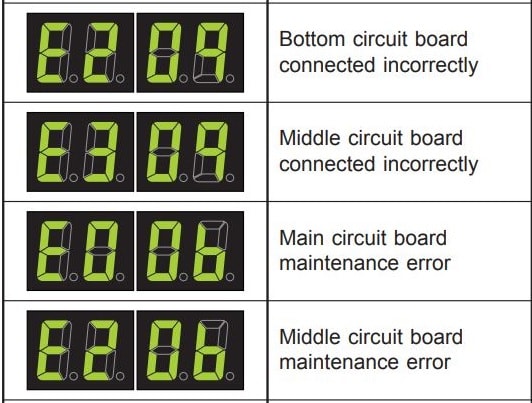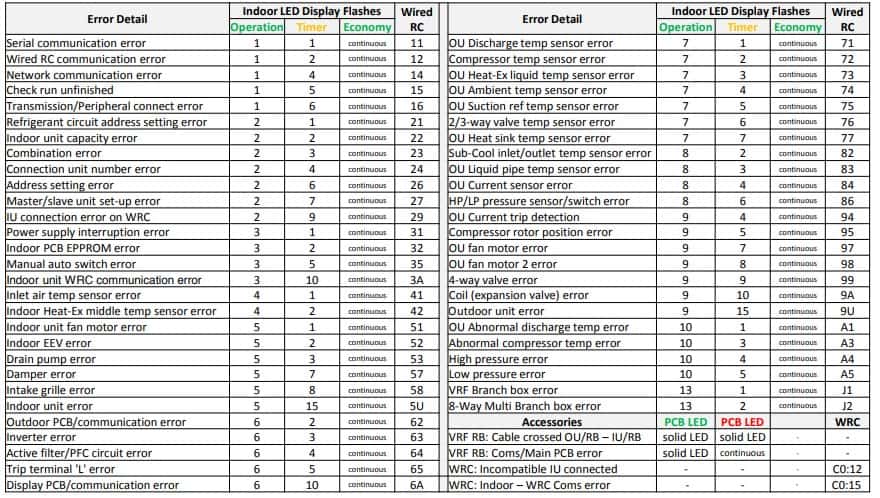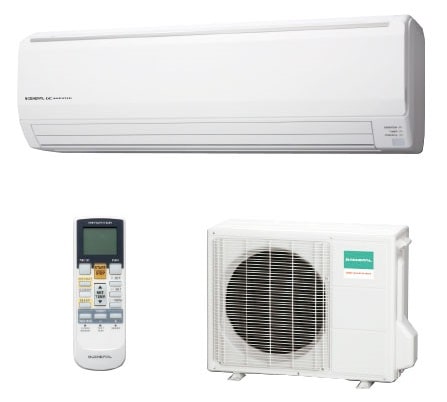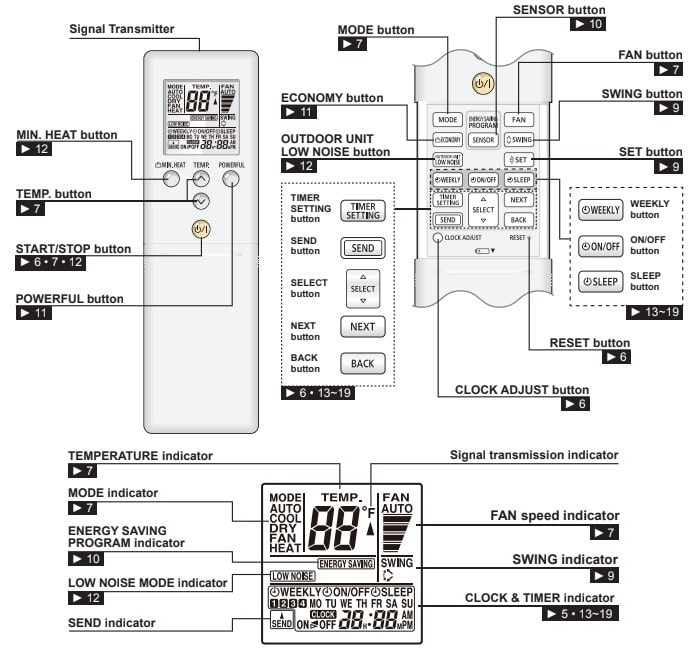High-SEER 410a Mini Splits Troubleshooting

Code Error Contents:
| Error Codes | Meaning |
|---|---|
| 01 | Indoor unit doesn’t accept signal from outdoor unit |
| 02 | Room temperature sensor open |
| 03 | Room temperature sensor short-circuited |
| 04 | Indoor heat exchanger temperature sensor open |
| 05 | Indoor heat exchanger temperature sensor short circuited |
| 06 | Outdoor heat exchanger temperature sensor |
| 08 | Power source connection error |
| 09 | Float switch operated |
| 0A | Outdoor temperature sensor error |
| 0c | Discharge pipe temperature sensor |
| 11 | Model abnormal/Indoor EPROM Abnormal |
| 12 | Indoor fan abnormal |
| 13 | Outdoor unit doesn’t accept the signal from indoor unit |
| 14 | Excessive outdoor pressure (permanent stop) |
| 15 | Compressor temperature sensor |
| 16 | Pressure switch error |
| 17 | IPM error |
| 18 | CT error |
| 19 | Active filter module (AFM) error |
| 1A | Compressor does not operate |
| 1b | Outdoor unit fan error |
| 1c | Communication error (inverter to multi controller) |
| 1d | 2 way valve sensor error |
| 1E | Expansion valve error |
| 1F | Connection indoor unit error |
LED Flash Error Contents:
| Flashing | Problem |
|---|---|
| 1 flash | Communication error (Indoor unit to Outdoor unit) |
| 2 flash | Discharge pipe temperature sensor |
| 3 flash | Outdoor heat exchanger temperature sensor |
| 4 flash | Outdoor temperature sensor |
| 7 flash | Compressor temperature sensor |
| 8 flash | Heat sink temperature sensor |
| 9 flash | Pressure switch abnormal |
| 12 flash | IPM error |
| 13 flash | Compressor rotor position cannot detect |
| 14 flash | Compressor cannot operate/Start up error |
| 15 flash | Outdor fan abnormal (upper fan) |
| 16 flash | Outdoor fan abnormal (lower fan) |
Outdoor Unit Display Error Display:

| Error Codes | Cause |
|---|---|
| 11 | Outdoor communication signal error (Forward transfer signal error) |
| 8 | Outdoor discharge pipe temperature thermistor error |
| 5 | Outdoor heat exchanger temperature thermistor error |
| 7 | Outdoor temperature thermistor error |
| 21 | 2-way valve temperature thermistor error |
| 22 | 3-way valve temperature thermistor error |
| 12 | Compressor temperature thermistor error |
| 19 | Heat sink temperature thermistor error |
| 13 | Pressure switch error |
| 23 | Connected indoor unit error |
| 14 | IPM error |
| 17 | Compressor rotor location cannot detect(permanent stop) |
| 20 | Compressor Start-up error (permanent stop) |
| 18 | Outdoor unit fan motor error |
| 24 | Main CPU - sub CPU communication error |
| 32 | 4-way valve error |

Wired Remote Controller Error Codes:
| Error Codes | Problem |
|---|---|
| 00 | No error |
| 02 | Model information abnormal |
| 04 | Power supply frequency abnormal |
| 06 | EEPROM access error |
| 07 | EEPROM deletion error |
| 09 | Room temperature themistor error |
| 0A | Indoor unit heat exchanger themistor (middle) error |
| 0b | Indoor unit heat exchanger themistor (inlet) error |
| 0C | Indoor unit heat exchanger themistor (outlet) error |
| 0d | Blower temperature themistor error |
| 11 | Drain abnormal |
| 12 | Room temperature abnormal |
| 13 | Indoor unit fan error |
| 1F | Transmission error |
| 20 | Node setting error |
| 21 | Parallel communication error |
| 32 | Outdoor unit error |
| 35 | Manual auto switch error |
| 41 | Room error |
| 42 | Indoor unit Heat Ex. sensor error |
| 51 | Indoor unit fan motor error |
| 53 | Water Drain error |
| 50 | Indoor unit error |
| 62 | Outdoor unit main PCB error |
| 63 | Inverter PCB error |
| 65 | IPM error |
| 71 | Discharge thermistor error |
| 86 | Pressure sensor error |
| 97 | Outdoor unitfan motor1 error |
| A1 | Discharge temperature 1 error |
| A3 | Compressor temperature error |
| A5 | Pressure error 2 |
| J2 | Unit flow divider error |
Fujitsu General AC Troubleshooting

In the event of a malfunction (burning smell, etc.), immediately stop operation, turn off the electrical breaker and consult authorized service personnel. Merely turning off the unit’s power switch will not completely disconnect the unit from the power source. Always be sure to turn off the electrical breaker to ensure that power is completely off.
Before requesting service, perform the following checks:
Symptom: Doesn’t operate immediately:
Problem:
- If the indoor unit is stopped and then immediately started again, the compressor will not operate for about 3 minutes, in order to prevent fuse blowouts.
- Whenever the electrical breaker is turned off then on again the protection circuit will operate for about 3 minutes, preventing unit operation during that period.
Symptom: Noise is heard
Problem:
- During operation or immediately after stopping the unit, the sound of water fl owing in the air conditioner’s piping may be heard. Also, noise may be particularly noticeable for about 2 to 3 minutes after starting operation (sound of refrigerant fl owing).
- During operation, a slight squeaking sound may be heard. This is the result of minute expansion and contraction of the front panel due to temperature changes.
- During Heating operation, a sizzling sound may be heard occasional. This sound is produced by the Automatic Defrosting operation.
Symptom: Smells
Problem: Some smell may be emitted from the indoor unit. This smell is the result of room smells (furniture, tobacco, etc.) which have been taken into the indoor unit.
Symptom: Mist or steam is emitted
Problem:
- During Cooling or Dry operation, a thin mist may be seen emitted from the indoor unit. This results from the sudden Cooling of room air by the cool air emitted from the indoor unit, resulting in condensation and misting.
- During Heating operation, the outdoor unit’s fan may stop, and steam may be seen rising from the unit. This is due to Automatic Defrosting operation.
Symptom: Airfl ow is weak or stops
Problem:
- When Heating operation is started, fan speed is temporarily very low, to allow internal parts to warm up.
- During Heating operation, if the room temperature rises above the temperature setting, the outdoor unit will stop, and the indoor unit will operate at very low fan speed. If you wish to warm the room further, set the temperature for a higher setting.
- During Heating operation, the indoor unit will temporarily stop operation (Max.15 minutes) as the Automatic Defrosting mode operates. During Automatic Defrosting operation, the OPERATION Indicator Lamp will fl ash.
- During Dry mode, the indoor unit will operate at low speed; in order to adjust room humidity, the indoor unit’s fan may stop from time to time. Also, the fan may operate at very low speed when adjusting room humidity.
- During SUPER QUIET operation, the fan will operate at very low speed.
- In the monitor of AUTO operation, the fan will operate at very low speed.
Symptom: Water is produced from the outdoor unit
Problem: During Heating operation, water may be produced from the outdoor unit due to Automatic Defrosting operation.
Symptom: Doesn’t operate at all
Problem:
- Has the circuit breaker been turn off?
- Has there been a power failure?
- Has a fuse blown out, or a circuit breaker been tripped?
- Is the intake grille completely closed?
- Is the timer operating?
Symptom: Poor Cooling (or Heating) performance
Problem:
- Is the Air Filter dirty?
- Are the air conditioner’s intake grille or outlet port blocked?
- Did you adjust the room temperature settings (temperature) correctly?
- Is there a window or door open?
- In the case of Cooling operation, is a window allowing bright sunlight to enter? (Close the curtains.)
- In the case of Cooling operation, are there heating apparatus and computers inside the room, or are there too many people in the room?
- Has OUTDOOR UNIT LOW NOISE not been set?
- Is the unit set for SUPER QUIET operation?
Symptom: The unit operates differently from the Remote Controller’s setting
Problem:
- Are the Remote Controller’s batteries dead?
- Are the Remote Controller’s batteries loaded properly?
If the problem persists after performing these checks, or if you notice burning smells, or the OPERATION Indicator Lamp and the TIMER Indicator Lamp flashes, and ECONOMY Indicator Lamp flashes fast. Immediately stop operation, turn off the electrical breaker and consult authorized service personnel.

source: https://www.fujitsugeneral.com
Comments